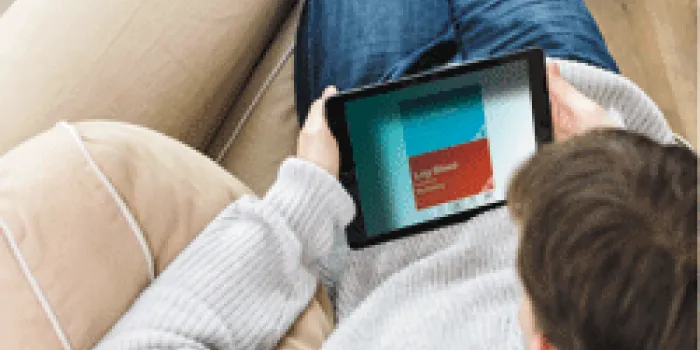Kyle Brown is fortunate that his hemophilia treatment center (HTC) kept ordering his medications. Ideally, his prophylaxis supply should have been based on a detailed log of how much he was using and how frequently he was having joint bleeds.
There was only one problem: filling out the paper logs. “It was an annoying step on top of an already annoying routine,” says Brown, 28, a stay-at-home dad from Inkster, Michigan, who used prophylaxis at least three times a week to treat his severe hemophilia A.
There were times when Brown got down to his last dose, only to have a bleed and need more medication express delivered to his home. But all that changed two years ago when he began logging his bleeds and prophylaxis use on a device that he always has on hand—his smartphone.
The mobile app explosion
It was inevitable that the two spheres would collide—mobile technology and management of chronic diseases, like hemophilia. After all, 58% of US adults own a smartphone and 42% own a tablet, according to January 2014 data from the Pew Research Internet Project, a nonpartisan think tank. At the same time, about half of all American adults have at least one chronic disease, according to the US Centers for Disease Control and Prevention.
Concurrently, health and medical mobile apps, tools that help people manage their own medical conditions and instantly get medical information, have soared. More than 100,000 mobile health apps have been developed, half in the last two and a half years alone, according to the May 2014 mHealth app Developer Economics 2014 report from research2guidance, a market research company focused on mobile apps.
Medical apps focus on everything from calorie counting and fitness to managing chronic diseases, such as hemophilia. “These tools are being adopted almost as quickly as they can be developed,” according to the US Food and Drug Administration’s (FDA) website.
As of August 2014, a search on the iTunes App Store for “hemophilia” brings up 26 different apps for iPhone and 10 apps for iPad, including the HemAware app for both devices. In the Google Play store, a “hemophilia” search reveals 25 apps.

andresr/Getty Images
Brown began using HemMobile, a Pfizer app, after his brother, who also has severe hemophilia, recommended it. HemMobile allows users to record the time, date and reason for every infusion. Users can take a photo of their bleed and send it to their HTC team for review. Another tool helps you find HTCs and National Hemophilia Foundation (NHF) chapters nearby and abroad. “It keeps track of everything,” Brown says. “I punch in the info while I’m getting my factor. It just takes a couple seconds.”
As more people turn to mobile devices to help them manage their bleeding disorders, experts are predicting that medical care will move in tandem. Instead of just logging bleeds, infusions and prophylactic inventory, physicians will use apps to make decisions.
From logging to decision making
Every six months, Brown heads to his HTC for a routine visit. This is where the electronic logs on his mobile app become active players in his medical care. Before a visit, he emails his HTC team an accurate log of how he’s been faring. Previously, he would try to remember what happened during the prior six months. “Everything is just so much easier,” Brown says. “My HTC knows everything that’s going on, every bleed. And being severe, that can happen often.”
The next step is including the data in treatment decisions. “I think more clinicians would love to have electronic logs, but there’s a gap in understanding their importance,” says Mark Skinner, JD, former president of both NHF and the World Federation of Hemophilia. Skinner has severe hemophilia A. “How clinicians use them varies widely. They need to be providing feedback to patients who are providing the data.”
Research has shown that apps help improve patients’ health outcomes. A 2013 study of people with type 1 diabetes in Australia found that those who used a smartphone app, combined with text messages from a clinician and regular medical care, had better blood sugar levels after nine months than those who didn’t. The results were published in the Journal of Medical Internet Research.
Skinner hopes that apps for hemophilia will show the same promise. He began using the app MicroHealth Hemophilia, created by an independent developer, about four years ago to log his factor usage and infusions. The app’s features are similar to HemMobile’s.
It’s time to take the next step, says Skinner. “The goal is real-time feedback,” he says. “Few of the apps link in to electronic medical records. That’s ultimately where we need this to go. That feedback will be key to decision making.”
Currently, patient logs can be captured within the American Thrombosis and Hemostasis Network (ATHN) Advoy database. The web-based tool, affiliated with HTCs across the country, is the only database that nationally logs patient bleeding and infusion patterns. Patients and healthcare providers can use it to gather and share treatment information, and detect trends that may improve individual clinical outcomes.
An app in the making
Skinner is anxiously anticipating the next generation of apps that will bridge the gap between tracking the condition and actually improving it. One such app developer is Daniel Bond, 60, an aerospace engineer from Galveston, Texas, who has severe hemophilia B.
Bond bought his first iPhone in 2007. Around the same time, he was going through the burdensome task of paper logging his infusions and bleeds. After a knee joint replacement surgery, he used a spreadsheet to manually calculate his factor level and next infusion time. When he checked his calculations against his blood tests, he found that they were fairly accurate. “I realized I could be putting this same information into an iPhone app to make it easier,” says Bond. But he wanted the app to go beyond that. “All the logging gives you a historical background, but I wanted something that would help me right now.”
So he developed iBleed, a forthcoming mobile app that will not only track bleeds and infusions, but will also predict key pieces of information. Those include the user’s current factor level, how many vials of factor are on hand and how much is needed to achieve the desired level in the bloodstream.
Bond’s app also allows the user to enter personal half-life as the basis for the calculations, creating more individualized prophylaxis schedules. It also can send automatic notifications to your HTC about when you infuse or have a breakthrough bleed.
Three years ago, a group of mobile app developers built a prototype, which Bond took to the University of Texas Gulf States Hemophilia and Thrombophilia Center in Houston. Pfizer agreed to fund a clinical trial with the center to test the accuracy of the app’s predictive power. Bond expects the clinical trial to conclude in 2015. The next step will be analyzing the data to see if the app actually works.
Still, even though Bond’s app seems extremely promising, and even if the clinical trial ends with glowing results, there’s a final hurdle before interested users can start downloading—the FDA.
The FDA hurdle
The FDA has noted the mobile app proliferation, and the potential for misuse. Just as it regulates drugs, lab tests and medical equipment, it also regulates mobile apps that meet its definition of medical devices. “When the intended use of a mobile app is for the diagnosis of disease or other conditions, or the cure, mitigation, treatment, or prevention of disease, or is intended to affect the structure or any function of the body of man, the mobile app is a device,” according to the FDA’s “Mobile Medical Application Guidance for Industry and Food and Drug Administration Staff,” published in September 2013.
Apps that are purely informational can go to market without getting FDA approval. Bond’s app falls somewhere in between. “The FDA just told us to show that it works,” he says. Hence, the clinical trial. And even though the trial is still underway, Bond is already looking at what the next iteration of the app will do. “If the HTC knows every time I have a bleed and do an infusion, which this app also can record, then they’ll know the best dosage schedules,” Bond says. “By tracking usage and bleeds, we can figure out the ideal treatment schedule for me.”
Tailoring medical care for individuals

Paul Bradbury/Glow Images
The real power of mobile apps for patients with bleeding disorders is tailoring medical care for individual needs rather than based on population-based ranges, says Steven Pipe, MD, pediatric medical director of the Hemophilia and Coagulation Disorders Program at the University of Michigan Health System in Ann Arbor. “It’s about bringing precision into play, understanding how a patient’s factor works in him, how high of a recovery he gets after infusion, and how long factor lasts,” he says.
If the mobile app can give the patient real-time data on the exact factor level at each hour of the day, medical care for hemophilia can move toward limiting bleeds that disrupt a patient’s quality of life. Pipe has been using this mode of treatment for the last 10 years. “Once I map out for my patients what their factor levels are like every day, there are some aha moments,” he says. “Many of them will say, ‘If I had known my level was that low, I would have chosen my activities differently or changed my infusion schedule.’ ” Pipe and his staff can then warn patients about when to
be careful.
This has led many of Pipe’s patients to use their mobile app logs to modify their infusion schedules. That way, they can still pursue their desired activities without the risk of a bleed. For instance, if a 12-year-old wants to play soccer, his HTC team can adjust his prophylaxis schedule around his practices or games.
This use of mobile apps can also improve quality of life for the whole family. “I was intrigued by a recent survey of caregivers who ranked the personal distress of seeing their child in pain as one of the most important determinants of their sense of well-being as a family,” Pipe says.
Using mobile technology may restore family peace by preventing bleeds and the painful complications that can ensue.
“This means we can treat the individual instead of just the disease,” says Mark Skinner. “The potential for those of us with hemophilia is more than just convenience. It’s security and freedom.”

